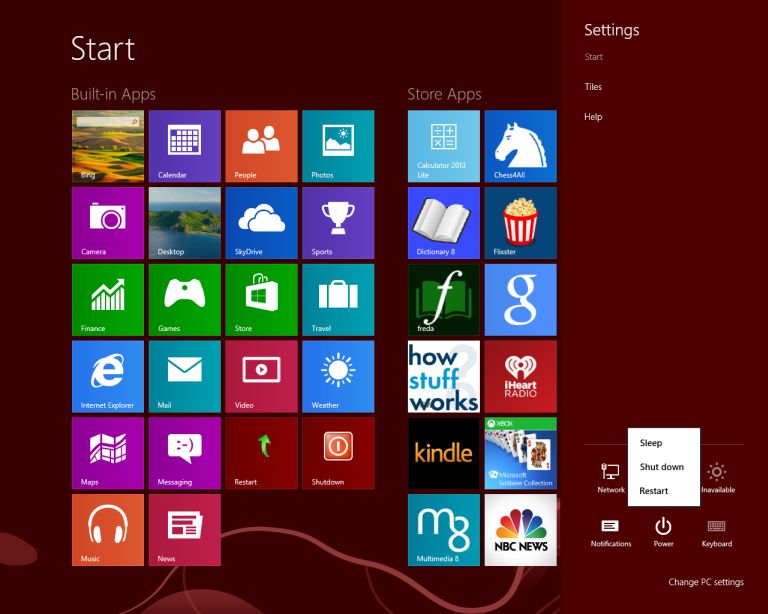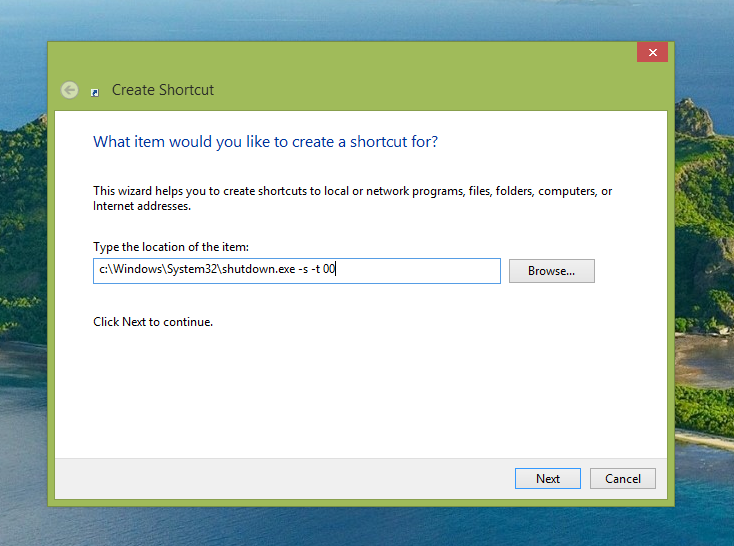Browse All Articles > Easily Shut Down or Restart Windows 8
The version of Windows introduced by Microsoft in 2012 seems to be a combination of the previous version of Windows, namely Windows 7, and the operating system of Apple's iPad. It is meant to be most compatible with a touchpad device, where a finger touch or gestures with the fingers take the place of a mouse left click or right click. However, it can also be used on a regular desktop pc or laptop pc with a mouse attached. As a matter of fact, I have Windows 8 on both my desktop pc and a laptop pc. (I dual boot Windows 8 with Windows 7 on my desktop machine.) In this article I refer to mouse clicks, but realize that on a touch device you merely touch the screen. A right click is usually done on a touch screen by pressing and holding down until a complete circle appears, then lifting your finger.
After you log into Windows 8 from what is called the Lock screen, you get what is called the Start screen. There is an icon for the Windows 8 Desktop application on the Start screen. Clicking (or touching) it will bring up the Windows Desktop. A screenshot of my Desktop screen is shown below.
![Empty Desktop screen]()
The Windows 8 Desktop is almost identical to the Windows 7 Desktop. There is an area where Desktop shortcuts can be generated, a Taskbar at the bottom of the screen (which can be moved to any other edge of the screen) where buttons are available for showing running programs. The Taskbar buttons may be pinned to it by means of a right click and choosing the option from the context menu "Pin to Taskbar." At the bottom left side of the Taskbar are already pinned icons for File Explorer (in all previous releases of Windows, this was known as Windows Explorer) and Internet Explorer, Microsoft's web browser. My Desktop screen in the screenshot above show a number of other icons pinned to the Taskbar.
But there is no Start button! This has caused a great deal of comment from users of Windows, for there has ALWAYS been a Start button at the left edge of the Taskbar, allowing you to access a Start Menu which contained a list of all (or most) of your programs, the Control Panel, Administrative Tools, Help and Support, and various other things. If you access this area of the Taskbar now, you get a small icon for the Start Screen and clicking (or touching) it takes you back to that. Of course, there are various companies, such as one called Stardock, that have modified Windows 8 to put back the Start button.
Accessing the Start button of previous versions of Windows also allowed you to shut down or restart your pc (although either two or more mouse clicks were needed to do so.) How do you do that with Windows 8? There is the normal way, which is somewhat involved, of shutting a Windows 8 pc down or restarting it. The usual way is to bring up the Charms bar, then the Settings screen, then finally the Power menu. This will have Shut Down and Restart on it. To activate the Charms bar, you either swipe in from the right edge of the screen (on a touch screen), or with a mouse you move it to the lower righthand corner of the screen or to the upper righthand corner and then move the mouse down towards the middle of the righthand edge of the screen. With a keyboard, you can also type the Windows key (WinKey) and I to display the Settings pane. There is a screenshot included of the Start screen with the Power menu on the Settings pane shown.
![PC Settings Power Menu]()
On previous versions of Windows, I always created shortcuts on the Desktop for shutting down the pc or restarting it. Perhaps you'd rather create shortcuts on the Desktop for shutting down or restarting the pc, because doing so will allow you to use only one click of the mouse, rather than the several involved in the normal way. You can even copy or move these shortcuts to the Taskbar or to the Start screen.
The easiest way to create the shortcut is to right click the Desktop and choose New and then Shortcut from the context menu that will appear.
![Right click with New Shortcut]()
The Create Shortcut wizard will start, and you type "C:\Windows\System32\shutdown.exe -s -t 00" or "C:\Windows\System32\shutdown.exe -r -t 00" (without the quotation marks) into the text box. (The first argument to shutdown.exe is -s for the shutdown case, and -r for the restart case.) This is shown for the shutdown case in the next screenshot.
![shutdown shortcut argument]()
On the next page of the shortcut wizard you give the shortcut a name (such as Shut Down or Restart) and click Finish.
![name of shutdown shortcut]()
These shortcuts will have a plain icon, but you can easily change that by right clicking the shortcut, choosing Properties from the context menu, then clicking the Change Icon button.
![Change icon shutdown shortcut]()
You will see a warning dialog that there is nothing in the shutdown.exe file to be used for an icon.
![No icons message]()
So you click OK and you will automatically be shown the icons in the %SystemRoot%\system32\Shell32.dll file. The icons from Shell32.dll that I used for shutting down the pc or restarting it are shown in the following screenshots.
![Shutdown shortcut in Shell32.dll]()
![Restart icon in Shell32.dll]()
Now, if you want, you can copy or move these icons from the Desktop to the Start screen by right clicking them and choosing Pin to Start from the menu. The icons will normally be created at the end of the list of icons on the Start screen, but you can click and drag them wherever you want.
![Restart icon with Pin to Start]()
After you log into Windows 8 from what is called the Lock screen, you get what is called the Start screen. There is an icon for the Windows 8 Desktop application on the Start screen. Clicking (or touching) it will bring up the Windows Desktop. A screenshot of my Desktop screen is shown below.

The Windows 8 Desktop is almost identical to the Windows 7 Desktop. There is an area where Desktop shortcuts can be generated, a Taskbar at the bottom of the screen (which can be moved to any other edge of the screen) where buttons are available for showing running programs. The Taskbar buttons may be pinned to it by means of a right click and choosing the option from the context menu "Pin to Taskbar." At the bottom left side of the Taskbar are already pinned icons for File Explorer (in all previous releases of Windows, this was known as Windows Explorer) and Internet Explorer, Microsoft's web browser. My Desktop screen in the screenshot above show a number of other icons pinned to the Taskbar.
But there is no Start button! This has caused a great deal of comment from users of Windows, for there has ALWAYS been a Start button at the left edge of the Taskbar, allowing you to access a Start Menu which contained a list of all (or most) of your programs, the Control Panel, Administrative Tools, Help and Support, and various other things. If you access this area of the Taskbar now, you get a small icon for the Start Screen and clicking (or touching) it takes you back to that. Of course, there are various companies, such as one called Stardock, that have modified Windows 8 to put back the Start button.
Accessing the Start button of previous versions of Windows also allowed you to shut down or restart your pc (although either two or more mouse clicks were needed to do so.) How do you do that with Windows 8? There is the normal way, which is somewhat involved, of shutting a Windows 8 pc down or restarting it. The usual way is to bring up the Charms bar, then the Settings screen, then finally the Power menu. This will have Shut Down and Restart on it. To activate the Charms bar, you either swipe in from the right edge of the screen (on a touch screen), or with a mouse you move it to the lower righthand corner of the screen or to the upper righthand corner and then move the mouse down towards the middle of the righthand edge of the screen. With a keyboard, you can also type the Windows key (WinKey) and I to display the Settings pane. There is a screenshot included of the Start screen with the Power menu on the Settings pane shown.

On previous versions of Windows, I always created shortcuts on the Desktop for shutting down the pc or restarting it. Perhaps you'd rather create shortcuts on the Desktop for shutting down or restarting the pc, because doing so will allow you to use only one click of the mouse, rather than the several involved in the normal way. You can even copy or move these shortcuts to the Taskbar or to the Start screen.
The easiest way to create the shortcut is to right click the Desktop and choose New and then Shortcut from the context menu that will appear.

The Create Shortcut wizard will start, and you type "C:\Windows\System32\shutd

On the next page of the shortcut wizard you give the shortcut a name (such as Shut Down or Restart) and click Finish.

These shortcuts will have a plain icon, but you can easily change that by right clicking the shortcut, choosing Properties from the context menu, then clicking the Change Icon button.
You will see a warning dialog that there is nothing in the shutdown.exe file to be used for an icon.
So you click OK and you will automatically be shown the icons in the %SystemRoot%\system32\Shel
Now, if you want, you can copy or move these icons from the Desktop to the Start screen by right clicking them and choosing Pin to Start from the menu. The icons will normally be created at the end of the list of icons on the Start screen, but you can click and drag them wherever you want.
Have a question about something in this article? You can receive help directly from the article author. Sign up for a free trial to get started.

Comments (2)
Commented:
This worked for me. Thanks.
Commented: